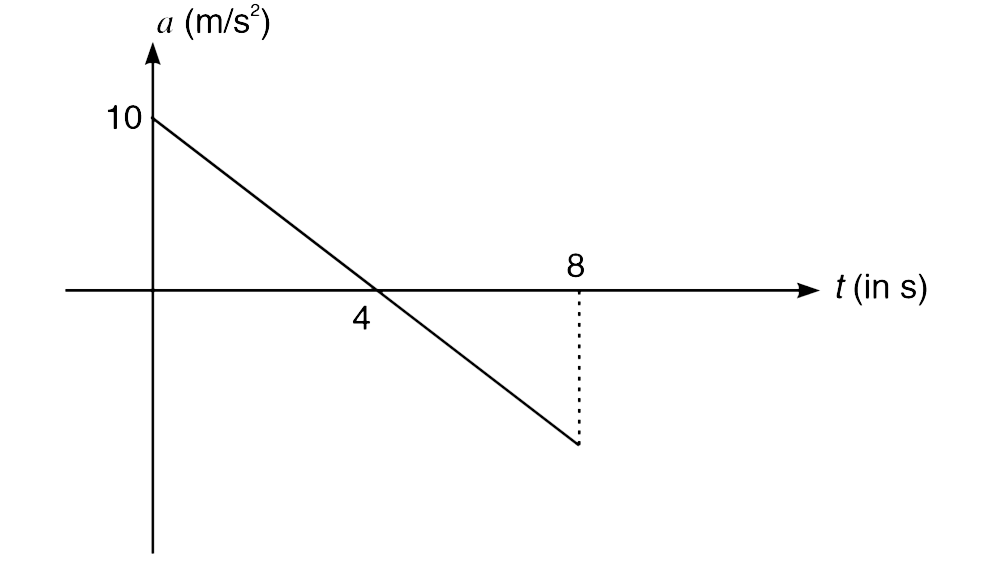A particle moves along a straight line according to the equation s = 8 cos 2t + 4sint. The initial velocity is Solution in Telugu
−5 units/sec
−4 units/sec
23e units/sec
5 units/sec
The correct Answer is:C
Step by step video, text & image solution for A particle moves along a straight line according to the equation s = 8 cos 2t + 4sint. The initial velocity is by Maths experts to help you in doubts & scoring excellent marks in Class 11 exams.
Updated on:21/07/2023Topper's Solved these Questions
- RATE MEASUREMENTBOOK - AAKASH SERIESCHAPTER - RATE MEASUREMENTEXERCISE - PRACTICE SHEET (EXERCISE - 1) (LEVEL - 1) (STRAIGHT OBJECTIVE TYPE QUESTION)
43 Videos
- PROPERTIES OF VECTORSBOOK - AAKASH SERIESCHAPTER - PROPERTIES OF VECTORSEXERCISE - PRACTICE EXERCISES
55 Videos
- RATE OF CHANGEBOOK - AAKASH SERIESCHAPTER - RATE OF CHANGEEXERCISE - Advanced Subjective Type Questions
22 Videos
Similar Questions
If a particle moves alonga straight line by S=4t2−8t+3 and the time at which the particle comes of rest is 't' seconds then '2t' is
View SolutionIf ¯¯¯¯¯¯OA=¯i+2¯j−3¯k,¯¯¯¯¯¯OB=3¯i−2¯j+5¯kand2¯¯¯¯¯¯AC=3¯¯¯¯¯¯AB then ¯¯¯¯¯¯AC=
View SolutionA stone is dropped into a quiet pond and waves move in circles outward from the place where it strikes, at a speed of 30 cm per second. At the instant when the radius of the wave ring is 50 mt, find the rate of increase in the area and in the circumference of the wave ring.
View SolutionThe acceleration-time graph of a particle moving along a straight line is as shown in. At what time the particle acquires its initial velocity? .
View SolutionA particle is moving in a straight line as : a=1m//s^(2) 0letle10 a=2t tgt10 where t is the time and a is the acceleration. If initial velocity of the particla is zero then :
View SolutionAcceleration vs time graph for a particle moving along a straight line is as shown. If the initial velocity of the particle is u=10m/s, draw a plot of its velocity vs time for 0<t<8.

View SolutionA particle moving in a straight in a straight line has velocity and displacement equation as v = 4 sqrt(1 + s) , where v is in m/s and s is in m. The initial velocity of the particle is:
View SolutionA particle moves along a straight line according to the law s=16−2t+3t3, where s metres is the distance of the particle from a fixed point at the end of t second. The acceleration of the particle at the end of 2s is
View SolutionPosition of a particle moving along a straight line is given by x=2t^(2)+t . Find the velocity at t = 2 sec.
View SolutionA particle moves along a line according to the law s=t4−5t2+8. The intial velocity is
View Solution[" A particle is moving along "],[" a straight line with non- "],[" uniform acceleration.The "],[" displacement of the "],[" particle is given by "],[S=2t^(3)+3t^(2)+5t" where "S" is in "],[" metres and "t" is in seconds."],[" The velocity of the particle "],[" at "t=2" seconds is "]
View Solution[" A particle is moving along "],[" a straight line with non- "],[" uniform acceleration.The "],[" displacement of the "],[" particle is given by "],[S=2t^(3)+3t^(2)+5t" where "S" is in "],[" metres and "t" is in seconds."],[" The velocity of the particle "],[" at "t=2" seconds is "]
View SolutionThe acceleration time graph of a particle moving along a straight line is as shown. The time at which the particle will have the velocity same as initial velocity (in s) is?
View SolutionThe displacement of a particle moving along a straight line is given by
s=3t^(3)+2t^(2)-10t. find initial velocity and acceleration of particle.
View SolutionThe acceleration-time graph of a particle moving along a straight line is as shown in. At what time the particle acquires its initial velocity?
 .
.
View Solution
